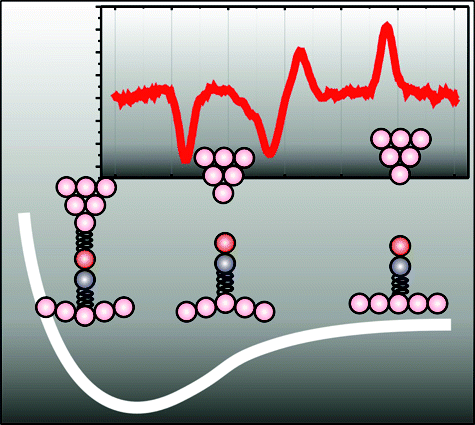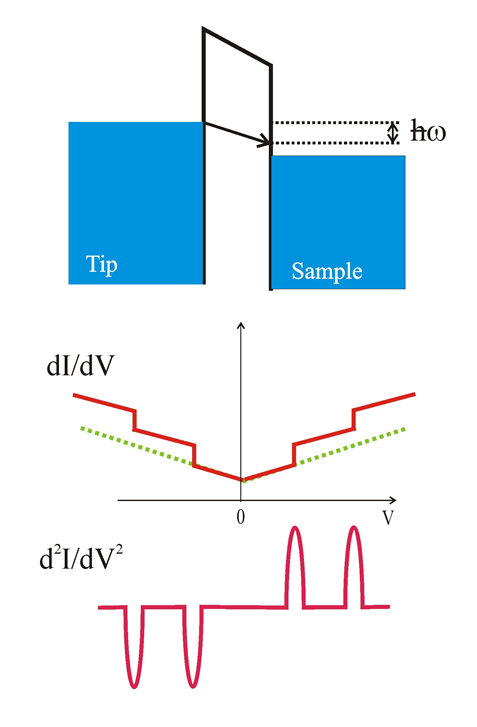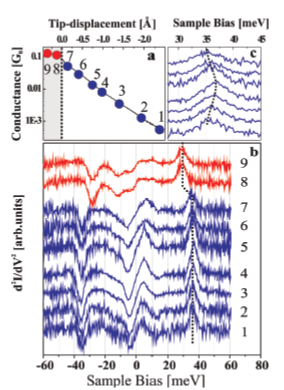Spectroscopy at atomic scale group
Phonons and lattice dynamics


Phonons and lattice vibrations characterize and identify structures and chemical elements in their nano-environment. Thus, characterizing lattice vibrations provides on one side information on the nature of chemical bonds within the molecule and of the molecule to the supporting substrate. On the other side, the characterization of the propagation of the lattice vibrations provides information on the heat transport in nanostructures.
Inelastic electron tunneling (IET) spectroscopy is based on the principle that few of the tunneling electrons can lose energy by exciting vibrations, phonons or plasmons in the adsorbate. The energy necessary to excite an inelastic loss is characteristics of the measured system and is an excellent fingerprint of the molecular configuration. At the energy of the loss, which is the onset for the additional tunneling contribution (or channel) a small peak onset can be observed in the spectra of the tunneling current. As the inelastic contribution to the tunneling current is small compared to the elastic tunneling, detecting the losses requires a system with a high stability. Due to the weak intensity of the signal, IET is usually measured as the second derivative of the tunneling current with respect to the voltage. Despite the small intensity of the signal, the IETS yields vibrational spectra of the adsorbates with energy resolution in the meV range and atomic or submolecular spatial resolution.
As lattice vibrations provide a clear identification of atomic structures, we have shown that lattice vibrations can be used to characterize the atomic termination of the tip of the scanning tunneling microscope (article).
Additionally, lattice vibrations can be surveyed to monitor the formation of metal-organic bonds. Even in case of weak chemical bonds the proximity of a metal contact can shift the lattice vibrations of a CO molecule (article).
IET provides accurate information to identify single wall carbon nanotubes (SWCNT) through their characteristic vibration called "radial breathing mode (RBM)". We have shown that even point defect affects the lattice vibrations for a lateral extension of about 0.2nm and that a minimal length of SWCNT is necessary to show a RBM (article). Phonon and plasmon losses can be measured also in extended structures as graphite (article).

Sketch of the IET process.

Conductance and vibrational spectra of individual CO molecules adsorbed on Cu(111) at differnt tip-sample distances.
L. Vitali, S. D. Borisova, G. G. Rusina, E.V. Chulkov, K. Kern.
Physical Review B 81, 153409 (2010)
article
L. Vitali, R. Ohmannn, K. Kern, A. Garcia-Lekue, T. Frederiksen, D. Sanchez-Portal, A. Arnau
Nano Letters 10, 657-660 (2010)
article
L.Vitali, M.Burghard, P.Wahl, M.A.Schneider, K.Kern
Physical Review Letters 96, 086804 (2006)
article
L.Vitali, M.Burghard, M.A.Schneider, Lei Liu, S.Y.Wu, C.S.Jayanthi, K.Kern
Physical Review Letters 93 136103 (2004)
article
L.Vitali, M.A.Schneider, K.Kern, L.Wirtz, A.Rubio
Physical Review B69, R121414 (2004)
article